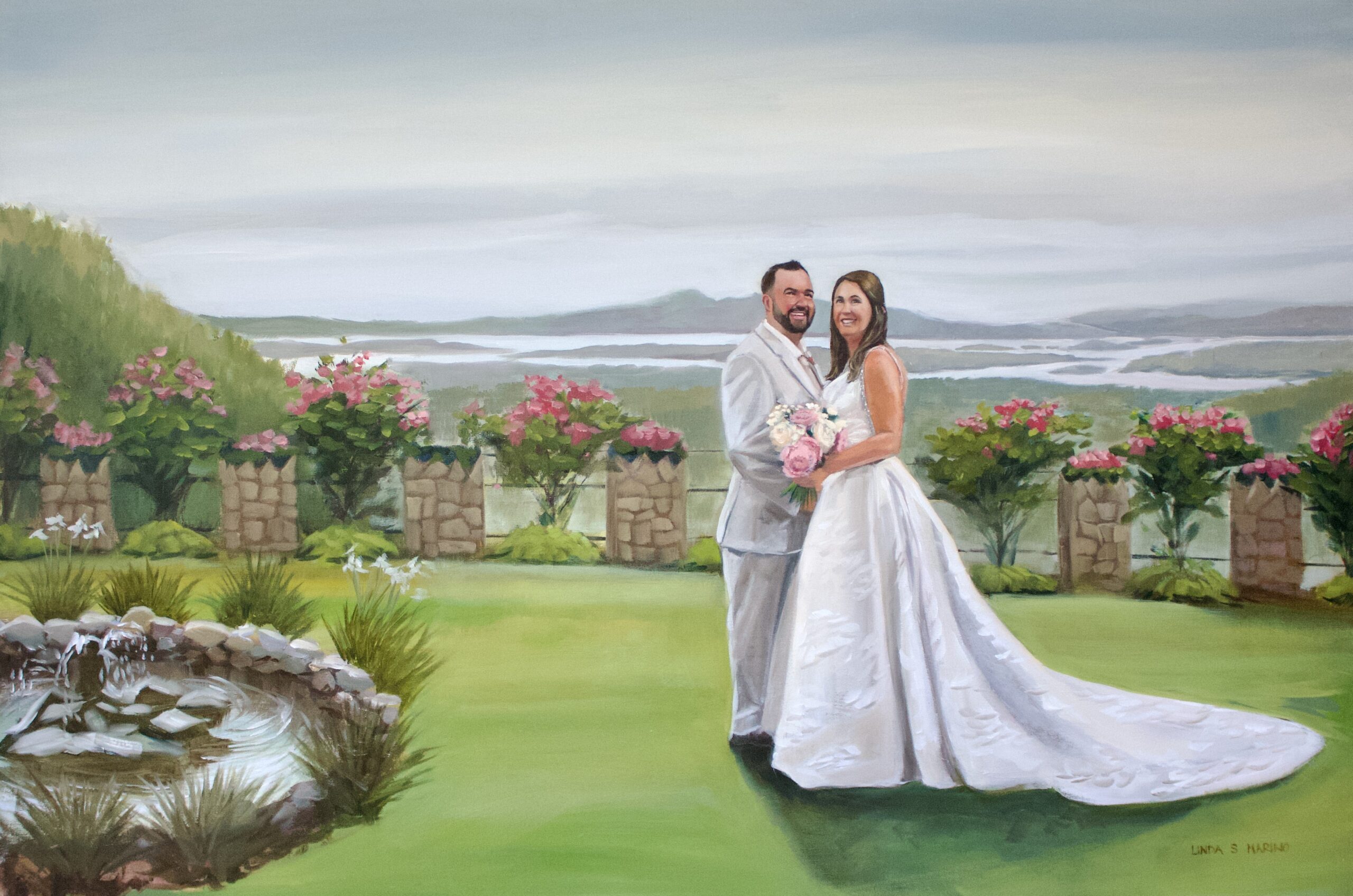Live wedding painting is more than just setting up an easel and capturing a beautiful moment—it’s about problem-solving. Every event presents unique challenges, from changing light to unexpected weather shifts. That’s why experience matters, not just in painting, but in plein air painting—the practice of painting on location.
Michelle and Alan’s wedding at Castle in the Clouds in Moultonborough, NH was a perfect example of why having a strong foundation in plein air painting is invaluable for a live painter.
🎥 Watch the full painting process from Michelle & Alan’s wedding here:
Capturing the Scene That Almost Was
When Michelle and Alan envisioned their wedding painting, they pictured their ceremony taking place on the back lawn of Castle in the Clouds, surrounded by the breathtaking mountain views, vibrant spring foliage, a fountain and rose garden. However, rain changed their plans—about 30 minutes before the ceremony, they made the difficult decision to move it inside to the Carriage House.
But here’s where plein air experience made all the difference. Instead of relying solely on photos to recreate the scene, I started the painting on location, in the exact spot where the ceremony was meant to take place. Even as a light drizzle fell, I worked under an overhang to capture the true colors of the landscape—something that simply can’t be replicated from a photograph alone.
Why Painting from Life is Different Than Painting from Photos
Many artists who are new to live painting rely heavily on reference photos—but this can create significant accuracy issues. A camera, no matter how high-quality, distorts reality in ways that the trained eye can correct when painting from life. Here’s why:
- Loss of Shadow Detail: In photos, dark areas tend to appear even darker, sometimes turning into near-black voids. In reality, shadows are filled with rich color variations—cool blues, warm purples, and reflected light from the surrounding environment. A trained plein air painter knows how to interpret and enhance these subtleties.
- Blown-Out Highlights: Just as shadows lose depth, bright areas can become overexposed, washing out details in the sky, flowers, or wedding attire. Painting on location helps preserve the balance of light and contrast.
- Perspective Distortion: Camera lenses, particularly wide-angle ones, can make objects appear farther away or skew proportions. When you’re painting live, you see depth and spatial relationships as they truly are, allowing for a more accurate and visually harmonious composition.
Having spent over a decade as a plein air painter, organizing groups, teaching classes, and serving as president of the Connecticut Plein Air Painters Society, I’ve trained my eyes to recognize and correct these distortions instinctively. This is why I always begin my live wedding paintings on location whenever possible, even if the scene changes later.
Adapting to the Unexpected
Once the ceremony moved indoors, I had to shift my approach. I continued painting the outdoor scene, knowing I would later add the couple into the composition based on reference photos taken after the ceremony. This is a skill that comes with experience—being able to merge the accuracy of plein air painting with the necessity of working from references.
Many new artists struggle with this balance. Relying too much on photos can create stiff, unnatural figures, while relying too much on memory can result in a lack of accuracy. The ability to integrate live observation with thoughtful reference use is what separates an experienced live painter from someone just starting out.
Why Experience Matters for Live Wedding Painting
For couples considering a live wedding painter, it’s important to understand that not all live painters are the same. Just like a seasoned wedding photographer knows how to adjust for changing light or capture fleeting moments, an experienced live painter knows how to problem-solve in real time.
Some key questions to ask when hiring a live painter:
✅ Do they have experience painting on location (plein air)?
✅ Do they understand how to adjust for lighting, perspective, and movement?
✅ How do they handle unexpected changes, like weather or venue shifts?
✅ Can they integrate live observation with photographic references seamlessly?
I share these insights not just for potential clients, but also for beginning artists who are interested in live painting. If you’re just starting out, plein air painting is one of the best ways to train your eye and develop the adaptability required for event painting. It takes years to build these skills, but the payoff is immense—both in terms of artistic growth and the quality of work you can provide to clients.
The Finished Painting: A Moment Preserved

Despite the unexpected weather changes, Michelle and Alan were thrilled with their painting. After completing the final details in my studio, I framed the piece and shipped it to them in New Hampshire, where it will serve as a lasting memory of their day—not just how it happened, but how they dreamed it would be.
For artists and collectors alike, this is what makes live painting so special. It’s not just about capturing an image—it’s about telling a story, interpreting light, and bringing a moment to life with artistry and skill.
If you’re an aspiring live painter, I encourage you to challenge yourself with plein air studies—train your eye, paint in different lighting conditions, and learn to work with nature instead of against it. And if you’re a couple considering a live painting for your wedding, remember: experience matters.